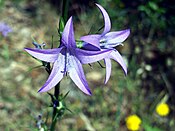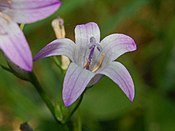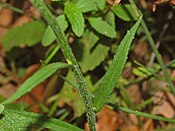Campanula rapunculus
| Campanula rapunculus | |
|---|---|

| |
| Scientific classification | |
| Kingdom: | Plantae |
| Clade: | Tracheophytes |
| Clade: | Angiosperms |
| Clade: | Eudicots |
| Clade: | Asterids |
| Order: | Asterales |
| Family: | Campanulaceae |
| Genus: | Campanula |
| Species: | C. rapunculus
|
| Binomial name | |
| Campanula rapunculus | |
Campanula rapunculus, common name rampion bellflower,[1] rampion, rover bellflower, or rapunzel, is a species of bellflower (Campanula) in the family Campanulaceae.[2]
This species was once widely grown in Europe for its leaves, which were used like spinach, and its parsnip-like root, which was used like a radish.[3] The Brothers Grimm's tale Rapunzel took its name from this plant.[4]
Etymology[]
The genus Latin name ("campanula"), meaning small bell, refers to the bell-shape of the flower, while the specific name ("rapunculus") is a diminutive of the Latin "rapa" (turnip) and means 'little turnip', which refers to the shape of the root.
Description[]

This biennial herbaceous plant reaches on average 40–80 centimetres (16–31 in) of height, with a maximum of 100 centimetres (39 in) . The stem is erect, lightly hairy, branched on the top. The basal leaves are petiolated, ovate, slightly toothed and arranged in a rosette, while the upper leaves are sessile and narrow lanceolate. The hermaphrodite flowers are clustered in a racemose inflorescence, with a bell-shaped, light blue or violet corolla, about two centimeters long. They are arranged along the stem in a fairly narrow one-sided facing cluster. The flowering period extends from May through September. The fruit is a dehiscent capsule in the form of inverted cone with many seeds. The thick root looks like a small turnip and it is edible.
Distribution[]
Campanula rapunculus is present in western Asia, northern Africa and in most of Europe, except Iceland, Ireland and Norway. It has been introduced in Denmark, southern Sweden and Great Britain. This species was once widely grown in Europe for its leaves, which were used like spinach, and its parsnip-like root, which was used like a radish.[3]
Habitat[]
This species prefers limestone soils and grows in dry meadows, cultivated beds, forests of oaks and pine trees, along roadsides and lane, at an altitude of 0–1,500 metres (0–4,921 ft) above sea level.
Synonyms[]
- Campanula elatior Hoffmanns. & Link
- Campanula lusitanica f. bracteosa (Willk.) Cout.
- Campanula lusitanica f. racemoso-paniculata (Willk.) Cout.
- Campanula lusitanica f. verruculosa (Hoffmanns. & Link) Cout.
- Campanula lusitanica var. cymoso-spicata (Willk.) Cout.
- Campanula lusitanica auct.
- Campanula verruculosa Hoffmanns. & Link
Gallery[]
Inflorescence of Campanula rapunculus
Flowers of Campanula rapunculus

Flowers of Campanula rapunculus

Close-up on flowers of Campanula rapunculus, lateral view
Close-up on flower of Campanula rapunculus
Leaf of Campanula rapunculus
References[]
Notes
- ^ BSBI List 2007 (xls). Botanical Society of Britain and Ireland. Archived from the original (xls) on 2015-06-26. Retrieved 2014-10-17.
- ^ Anderberg, Arne; Anderberg, Anna-Lena. "Campanula rapunculus". Den virtuella floran (in Swedish). Swedish Museum of Natural History. Retrieved 27 November 2010.
- ^ a b Rines, George Edwin, ed. (1920). . Encyclopedia Americana.
- ^ Grimm, Jacob Ludwig Karl; Grimm, Wilhelm; Crick, Joyce (2005). "11. Rapunzel". Selected tales. Oxford world's classics. Oxford: Oxford University Press. p. 51. ISBN 9780192804792. OCLC 799426092.
...when she noticed a bed planted with the most beautiful rampions, or rapunzels...
Bibliography
- Pignatti S. (1982) Flora d'Italia, Vol. II. Edagricole. p.687.
External links[]
| Wikimedia Commons has media related to Campanula rapunculus. |
- Campanula
- Flora of North Africa
- Flora of Western Asia
- Plants described in 1753
- Taxa named by Carl Linnaeus
- Root vegetables
- Asterales stubs





